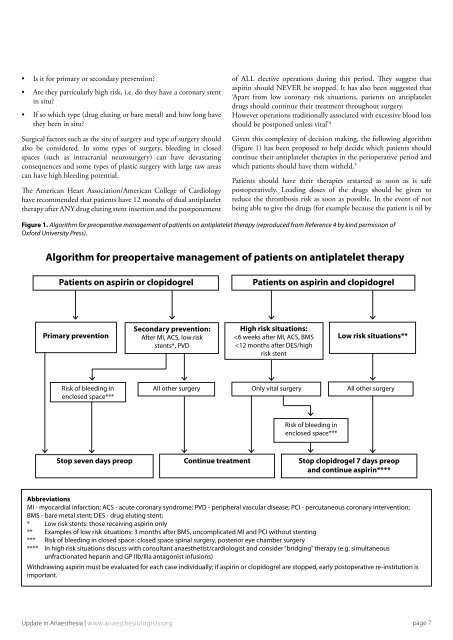Surgically placed rectus sheath catheters - The Global Regional ...
Surgically placed rectus sheath catheters - The Global Regional ...
Surgically placed rectus sheath catheters - The Global Regional ...
Create successful ePaper yourself
Turn your PDF publications into a flip-book with our unique Google optimized e-Paper software.
• Is it for primary or secondary prevention?<br />
• Are they particularly high risk, i.e. do they have a coronary stent<br />
in situ?<br />
• If so which type (drug eluting or bare metal) and how long have<br />
they been in situ?<br />
Surgical factors such as the site of surgery and type of surgery should<br />
also be considered. In some types of surgery, bleeding in closed<br />
spaces (such as intracranial neurosurgery) can have devastating<br />
consequences and some types of plastic surgery with large raw areas<br />
can have high bleeding potential.<br />
<strong>The</strong> American Heart Association/American College of Cardiology<br />
have recommended that patients have 12 months of dual antiplatelet<br />
therapy after ANY drug eluting stent insertion and the postponement<br />
of ALL elective operations during this period. <strong>The</strong>y suggest that<br />
aspirin should NEVER be stopped. It has also been suggested that<br />
‘Apart from low coronary risk situations, patients on antiplatelet<br />
drugs should continue their treatment throughout surgery.<br />
However operations traditionally associated with excessive blood loss<br />
should be postponed unless vital’ 4<br />
Given this complexity of decision making, the following algorithm<br />
(Figure 1) has been proposed to help decide which patients should<br />
continue their antiplatelet therapies in the perioperative period and<br />
which patients should have them witheld. 5<br />
Patients should have their therapies restarted as soon as is safe<br />
postoperatively. Loading doses of the drugs should be given to<br />
reduce the thrombosis risk as soon as possible. In the event of not<br />
being able to give the drugs (for example because the patient is nil by<br />
Figure 1. Algorithm for preoperative management of patients on antiplatelet therapy (reproduced from Reference 4 by kind permission of<br />
Oxford University Press).<br />
Algorithm for preopertaive management of patients on antiplatelet therapy<br />
Patients on aspirin or clopidogrel<br />
Patients on aspirin and clopidogrel<br />
Primary prevention<br />
Secondary prevention:<br />
After MI, ACS, low risk<br />
stents*, PVD<br />
High risk situations:<br />
















